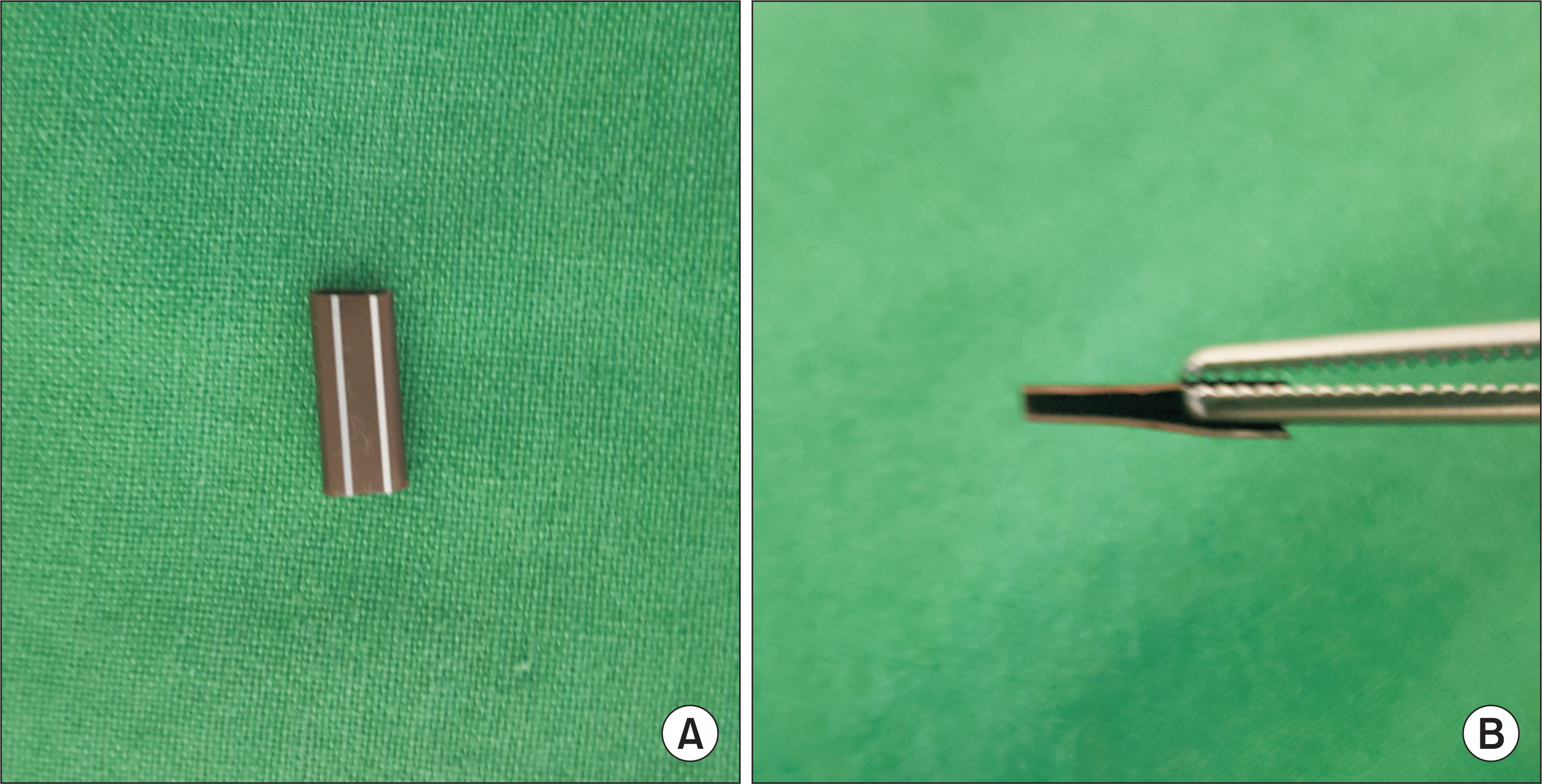J Korean Foot Ankle Soc.
2018 Sep;22(3):111-115. 10.14193/jkfas.2018.22.3.111.
Gutter Splint for Ingrown Toe Nail in Young Patients
- Affiliations
-
- 1Department of Orthopedic Surgery, Sanggye Paik Hospital, Inje University College of Medicine, Seoul, Korea. woonysos@daum.net
- KMID: 2428668
- DOI: http://doi.org/10.14193/jkfas.2018.22.3.111
Abstract
- PURPOSE
Ingrown toenails are a common disease in the adolescent period and the treatments could be more conservative for this early stage of the disease. This study is a case series on the results of a gutter splint for an adolescent ingrown toe nail as a simple, comfortable treatment method.
MATERIALS AND METHODS
From 2011 to 2018, 22 patients (mean age, 12.2 years; range, 8~15 years) with ingrown toenails were treated with a gutter splint. There were 16 boys and 6 girls with 7 patients on both great toes, and additional 4 both corners of a nail, giving a total of 33 splints. Flat, plastic straws and glue or suture were used to protect the nail corners under local anesthesia. The medical records were reviewed retrospectively and phone calls were made to obtain the long-term results.
RESULTS
Fifteen splints were fixed with a suture and the other 18 splints were fixed with glue. There were 9 cases of recurrence out of 33 gutter splints, 8 out of 15 sutured splints and 1 out of 18 glued splints (p=0.010). There was no gender (p=0.383) or age (p=0.305) difference in the number of recurrences.
CONCLUSION
For growing people, ingrown nails can be cured easily by conservative treatment for a transiently shortened or broken toenail. The glued gutter splint had a reasonable success rate as a first line treatment.
MeSH Terms
Figure
Reference
-
References
1. Aksakal AB, Oztas P, Atahan C, Gurer MA. Decompression for the management of onychocryptosis. J Dermatolog Treat. 2004; 15:108–11.
Article2. Freiberg A, Dougherty S. A review of management of ingrown toenails and onychogryphosis. Can Fam Physician. 1988; 34:2675–81.3. Zaraa I, Dorbani I, Hawilo A, Mokni M, Ben Osman A. Segmental phenolization for the treatment of ingrown toenails: technique report, follow up of 146 patients, and review of the literature. Dermatol Online J. 2013; 19:18560.
Article4. Yang G, Yanchar NL, Lo AY, Jones SA. Treatment of ingrown toenails in the pediatric population. J Pediatr Surg. 2008; 43:931–5.
Article5. Mitchell S, Jackson CR, Wilson-Storey D. Surgical treatment of ingrown toenails in children: what is best practice? Ann R Coll Surg Engl. 2011; 93:99–102.
Article6. Lloyd-Davies RW, Brill GC. The aetiology and outpatient management of ingrowing toenails. Br J Surg. 1963; 50:592–7.
Article7. Zuber TJ, Pfenninger JL. Management of ingrown toenails. Am Fam Physician. 1995; 52:181–90.8. Heifetz CJ. Ingrown toenail: a clinical study. Am J Surg. 1937; 38:298–315.9. Rauch C, Cherkaoui-Rbati M. Physics of nail conditions: why do ingrown nails always happen in the big toes? Phys Biol. 2014; 11:066004.
Article10. Grover C, Khurana A, Bhattacharya SN, Sharma A. Controlled trial comparing the efficacy of 88% phenol versus 10% sodium hydroxide for chemical matricectomy in the management of ingrown toenail. Indian J Dermatol Venereol Leprol. 2015; 81:472–7.
Article11. Eekhof JA, Van Wijk B, Knuistingh Neven A, van der Wouden JC. Interventions for ingrowing toenails. Cochrane Database Syst Rev. 2012; 4:CD001541.
Article12. Ceren E, Gokdemir G, Arikan Y, Purisa S. Comparison of phenol matricectomy and nail-splinting with a flexible tube for the treatment of ingrown toenails. Dermatol Surg. 2013; 39:1264–9.
Article13. Haricharan RN, Masquijo J, Bettolli M. Nail-fold excision for the treatment of ingrown toenail in children. J Pediatr. 2013; 162:398–402.
Article14. Shih YH, Huang CY, Lee CC, Lee WR. Nail brace application: a noninvasive treatment for ingrown nails in pediatric patients. Dermatol Surg. Published online May 2. 2018; doi:10. .1097/DSS.0000000000001530.15. Kim YJ, Ko JH, Choi KC, Lee CG, Lim KJ. Nail-splinting technique for ingrown nails: the therapeutic effects and the proper removal time of the splint. Dermatol Surg. 2003; 29:745–8.
Article16. Lazar L, Erez I, Katz S. A conservative treatment for ingrown toenails in children. Pediatr Surg Int. 1999; 15:121–2.
Article
- Full Text Links
- Actions
-
Cited
- CITED
-
- Close
- Share
- Similar articles
-
- The Therapeutic Effect of Nail Splinting in Ingrown Toenails
- A Study of Nail-splinting Technique with Flexible Plastic Tube in Ingrown Nail
- Clinical Study of Efficacy of Super Elastic Wire for Ingrown Nails of Great Toe
- Success Rates of Multiple Treatments for Ingrown Nails
- A Comparison of Sugar Tong Splint and Radial Gutter Short Arm Splint after Closed Reduction of Distal Radius Fracture



